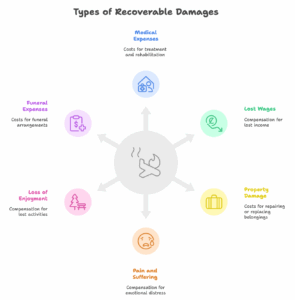Airplane accidents, thankfully, are rare. However, when they happen, the consequences can be devastating. If you or a loved one has been injured in an aviation incident, understanding your rights and the process of claiming compensation is crucial. This guide offers a practical overview of navigating the complex world of aviation law and securing the damages you deserve.
Understanding Your Rights After an Airplane Accident: An Introduction to Aviation Law
Aviation law is a specialised area dealing with the operation and regulation of aircraft and the use of airspace. The right to claim compensation following an airplane accident, whether on a commercial flight or private plane, stems from several legal avenues. Crucially, understanding the distinction between commercial and private aviation is essential. Commercial flights operate under stringent safety regulations, meaning breaches leading to accidents are often easier to pinpoint.
International air travel is governed by agreements like the Montreal Convention, which establishes liability rules for international carriage by air, particularly concerning passenger injury or death. It sets a limit on liability, but this limit can be exceeded if the airline is proven to have acted negligently. This is in contrast to domestic flights, which will often come under national laws.
In the UK, the Civil Aviation Act 1982 plays a crucial role. This Act, along with relevant EU regulations now enshrined in UK law post-Brexit, establishes the framework for holding airlines and other parties accountable for accidents. Also of relevance is the Carriage by Air Act 1961, which incorporates aspects of the Warsaw Convention (predecessor to the Montreal Convention) into UK law.
Consider the Air France Flight 447 disaster in 2009, where families sought substantial compensation after the crash. This highlights the complexities of proving liability in cases involving multiple factors, including pilot error and equipment malfunction.
Documenting the Airplane Accident: Evidence Gathering and Injury Assessment
The cornerstone of any successful accident claim is solid evidence. Immediately following an accident, prioritise seeking medical attention and meticulously document all injuries. This includes photographs, medical reports, and receipts for any related expenses.
Gathering evidence can be challenging. Secure a copy of the official accident report from the Air Accidents Investigation Branch (AAIB) in the UK (the equivalent of the NTSB in the US). The AAIB and the Federal Aviation Administration (FAA) conduct thorough investigations to determine the cause of the accident. Their findings can be instrumental in proving negligence.
Furthermore, collect witness statements, passenger manifests, and any personal records relating to the flight. For instance, a passenger who used their phone to record part of the flight may have unintentionally captured evidence that can support your claim.
Don’t underestimate the importance of a detailed personal journal. Record everything you remember about the accident, your injuries, and their impact on your life. This can be invaluable when recalling details later.
Identifying Liable Parties in an Aviation Accident Claim
Determining who is responsible for an airplane accident can be intricate. Potential liable parties include:
- The Airline: For operational negligence, inadequate maintenance, or pilot error.
- The Aircraft Manufacturer: For defective aircraft design or manufacturing flaws.
- Air Traffic Control: For negligence in directing the flight.
- Maintenance Providers: For faulty repairs or inadequate inspections.
- Component Manufacturers: If a specific part failure caused or contributed to the accident.
Consider the case of the Kegworth air disaster in 1989, where a fan blade fractured in one of the engines. The accident exposed issues of engine design and maintenance, leading to claims against both the airline and the engine manufacturer.
Types of Damages Recoverable After an Airplane Accident Injury
The damages you can recover following an aviation accident injury can be substantial and encompass both economic and non-economic losses. These may include:
- Medical Expenses: Past and future costs of treatment, rehabilitation, and medication.
- Lost Wages: Compensation for income lost due to your injuries, both past and future.
- Property Damage: Replacement or repair costs for damaged belongings.
- Pain and Suffering: Compensation for physical pain, emotional distress, and mental anguish.
- Loss of Enjoyment of Life: Compensation for the inability to participate in activities you previously enjoyed.
- Funeral Expenses: In cases of wrongful death.

A less obvious, but equally important aspect is psychological trauma. Many survivors of air accidents suffer from post-traumatic stress disorder (PTSD), anxiety, and depression. These conditions are treatable, and the costs of therapy and counselling are recoverable.
Building Your Airplane Accident Claim: Negotiation and Litigation Strategies
The process of claiming compensation typically begins with filing a claim with the liable party’s insurance company. This is where experienced legal representation becomes invaluable. A solicitor can help you assess the full extent of your damages, gather evidence, and negotiate with the insurance company on your behalf.
If a fair settlement cannot be reached through negotiation, litigation may be necessary. This involves filing a lawsuit in court and presenting your case to a judge or jury.
Alternative dispute resolution (ADR) methods, such as mediation, offer a less adversarial and often quicker route to settlement. Mediation involves a neutral third party who helps facilitate negotiations between you and the liable party.
Many solicitors offer “No-Win No-Fee” agreements, also known as Conditional Fee Agreements (CFA). This means you only pay legal fees if your claim is successful.
Proving Your Case: Establishing Causation in Aviation Injury Claims
A critical element in any personal injury claim is establishing causation – proving that the accident directly caused your injuries. This requires expert testimony from medical professionals, accident reconstruction specialists, and other qualified individuals.
For example, if you suffered a back injury, your medical records and a doctor’s testimony must demonstrate that the injury was a direct result of the forces experienced during the accident.
Navigating the Claims Process and Maximizing Your Compensation After an Airplane Accident
Successfully navigating an aviation injury claim demands expertise and meticulous preparation. Remember, statutes of limitations apply, meaning you have a limited time to file a claim. Deadlines vary depending on the jurisdiction and the nature of the flight (domestic vs. international). Missing the deadline means losing your right to seek compensation.
Securing the maximum compensation requires a strategic approach: document everything, seek expert legal advice, and be prepared to negotiate or litigate your claim. While no amount of money can undo the trauma of an accident, appropriate compensation can provide financial security and access to the resources needed for recovery.






Great – I should definitely pronounce, impressed with your web site. I had no trouble navigating through all the tabs as well as related info ended up being truly easy to do to access. I recently found what I hoped for before you know it in the least. Quite unusual. Is likely to appreciate it for those who add forums or something, site theme . a tones way for your customer to communicate. Excellent task.